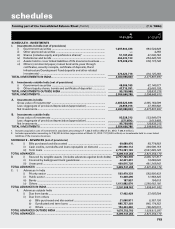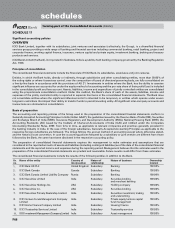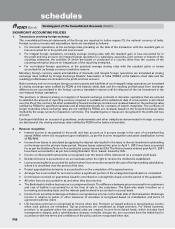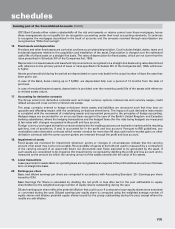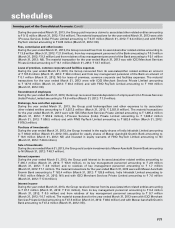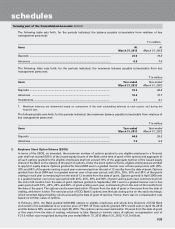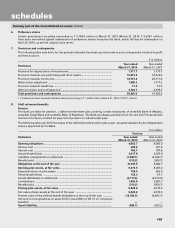ICICI Bank 2013 Annual Report Download - page 151
Download and view the complete annual report
Please find page 151 of the 2013 ICICI Bank annual report below. You can navigate through the pages in the report by either clicking on the pages listed below, or by using the keyword search tool below to find specific information within the annual report.
F73
than temporary in the carrying amounts of investments, the resultant reduction in the carrying amount is charged
to the profit and loss account during the period in which such decline is identified.
iii) The Bank’s primary dealership and securities broking subsidiaries classifies the securities held with the intention of
holding for short-term and trading as stock-in-trade and are valued at lower of cost or market value. The securities
acquired with the intention of holding till maturity or for a longer period are classified as investments and are
carried at cost. Appropriate provision is made for other than temporary diminution in the value of investments.
Commission earned in respect of securities acquired upon devolvement is reduced from the cost of acquisition.
iv) The Bank’s housing finance subsidiary classifies its investments as current investments and long-term investments.
Investments that are readily realisable and intended to be held for not more than a year are classified as current
investments, which are carried at the lower of cost and net realisable value. All other investments are classified as
long-term investments, which are carried at their acquisition cost or at amortised cost, if acquired at a premium
over the face value. Any premium over the face value of the securities acquired is amortised over the remaining
period to maturity on a constant yield basis. However, a provision for diminution in value is made to recognise any
other than temporary decline in the value of such long-term investments. Costs such as brokerage, commission etc.
paid at the time of acquisition of investments are included in the investment cost.
v) The Bank’s overseas banking subsidiaries account for unrealised gain/loss, net of tax, on investment in ‘Available
for Sale’ category directly in their reserves. Further, in the case of the Bank’s United Kingdom and Canadian banking
subsidiaries, unrealised gain/loss on investment in ‘Held for Trading’ category is accounted directly in the profit and
loss account.
vi) In the case of life and general insurance businesses, investments are made in accordance with the Insurance Act,
1938, the IRDA (Investment) Regulations, 2000, and various other circulars/notifications issued by the IRDA in this
context from time to time.
In the case of life insurance business, valuation of investments (other than linked business) is done on the following basis:
a. All debt securities and redeemable preference shares are considered as ‘Held to Maturity’ and accordingly
stated at historical cost, subject to amortisation of premium or accretion of discount in the profit or loss
account over the period of maturity/holding on a straight line basis.
b. Listed equity shares are stated at fair value being the last quoted closing price on the National Stock Exchange
(NSE) [in case of securities not listed on NSE, the last quoted closing price on the Bombay Stock Exchange
(BSE) is used].
c. Mutual fund units at the balance sheet date are valued at the latest available net asset values of the respective
fund.
Unrealised gains/losses arising due to changes in the fair value of listed equity shares and mutual fund units are
taken to ’Revenue and other reserves’ in the balance sheet for life insurance business.
In the case of general insurance business, valuation of investments is done on the following basis:
a. All debt securities including government securities and non-convertible preference shares are considered
as ‘Held to Maturity’ and accordingly stated at amortised cost determined after amortisation of premium or
accretion of discount on a straight line basis over the holding/maturity period.
b. Listed equities and convertible preference shares at the balance sheet date are stated at fair value, being the
lowest of last quoted closing price on NSE or BSE.
c. Mutual fund investments (other than venture capital fund) are stated at fair value, being the closing net asset
value at balance sheet date.
d. Investments other than mentioned above are valued at cost.
Unrealised gains/losses arising due to changes in the fair value of listed equity shares and mutual fund units are
taken to ’Revenue and other reserves’ in the balance sheet for general insurance business.
The general insurance subsidiary assesses at each balance sheet date whether there is any indication that any
investment in equity or units of mutual fund may be impaired. If any such indication exists, the carrying value of
such investment is reduced to its recoverable amount and the impairment loss is recognised in the revenue(s)/
profit and loss account.
The total proportion of investments for which subsidiaries have applied accounting policies different from the Bank as
mentioned above, is approximately 15.75% of the total investments at March 31, 2013.
14. Provisions/write-offs on loans and other credit facilities
i) Loans and other credit facilities of the Bank are accounted for in accordance with the extant RBI guidelines as given below:
a) All credit exposures, including loans and advances at the overseas branches and overdues arising from crystallised
derivative contracts, are classified as per RBI guidelines, into performing and NPAs. Loans and advances held at
the overseas branches that are identified as impaired as per host country regulations but which are standard as per
the extant RBI guidelines are identified as NPAs at a borrower level. Further, NPAs are classified into sub-standard,
doubtful and loss assets based on the criteria stipulated by RBI.
forming part of the Consolidated Accounts (Contd.)
schedules


